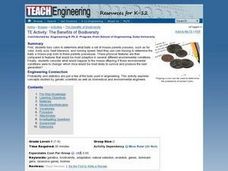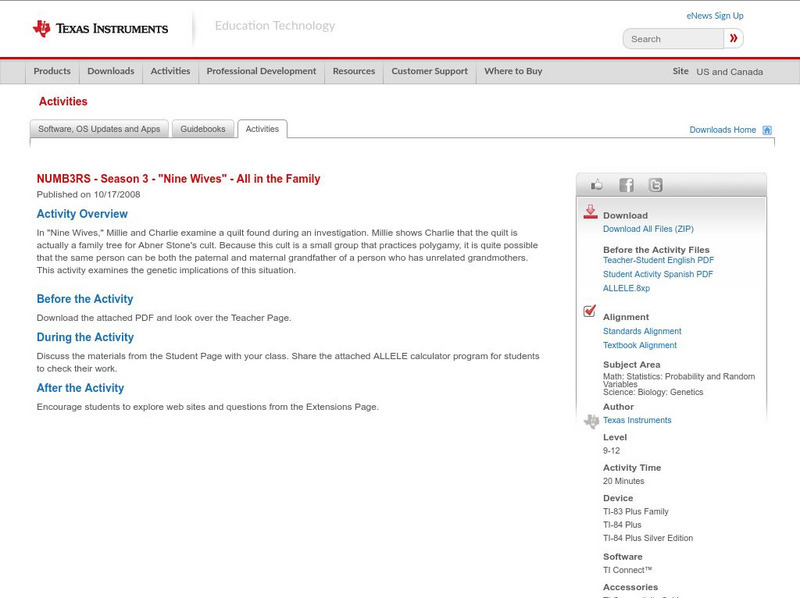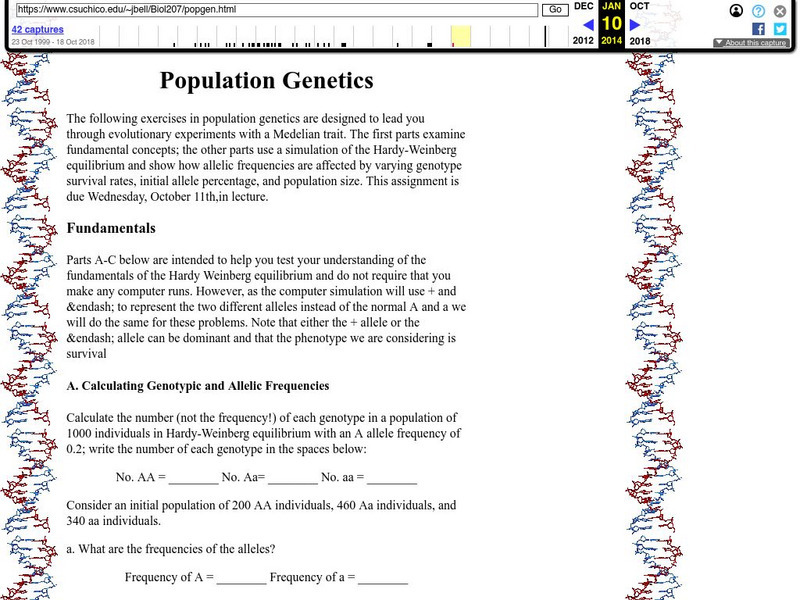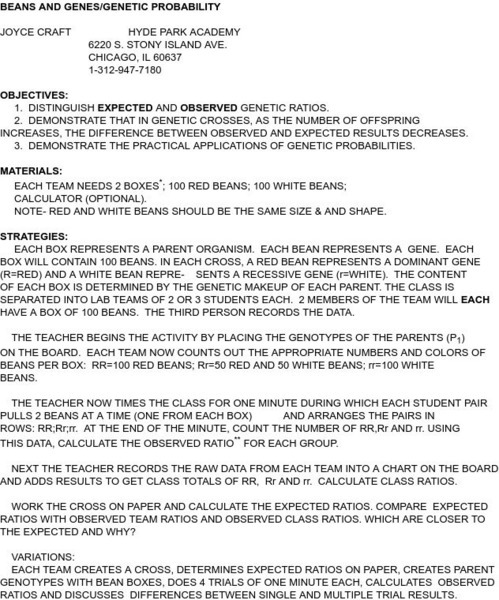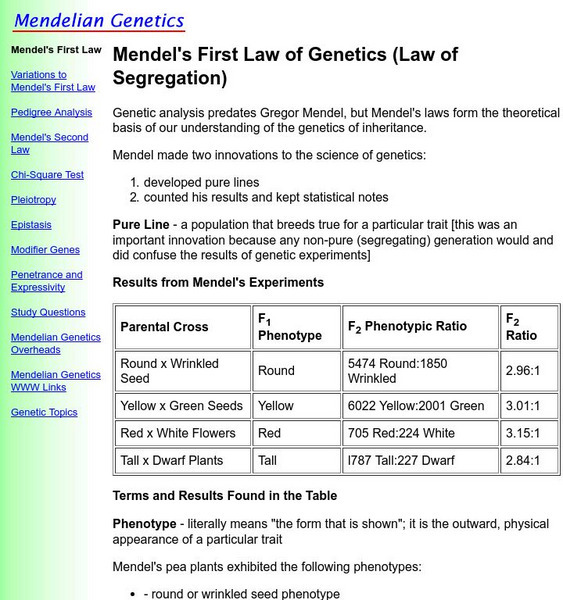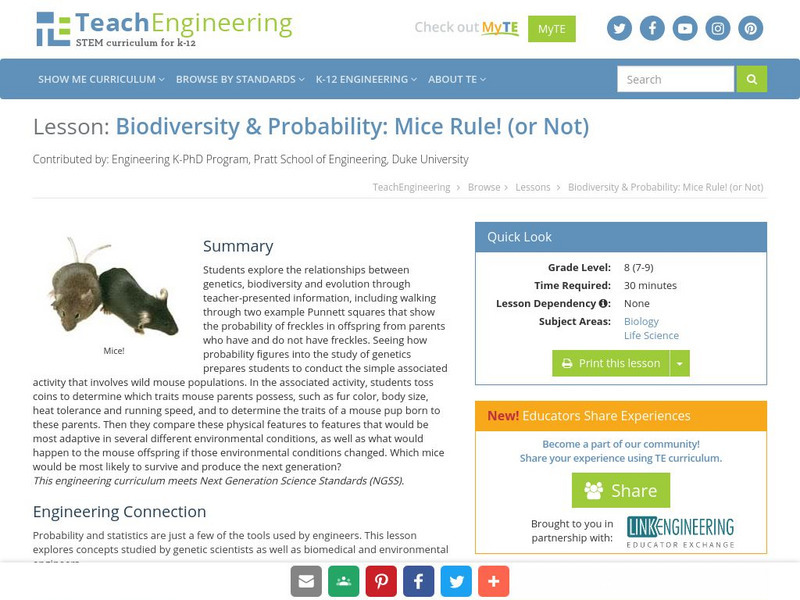Curated OER
The Benefits of Biodiversity
Students examine the concept of biodiversity. They toss coins to determine what traits mouse parents have and the babies traits as well. They predict what would happen to the baby mice if the traits of the parents were different.
Curated OER
Barnacles: Harder than Cement
Fourth graders watch the movements of the complex animal hidden inside the tiny barnacle shells. This lesson allows students to study the behavior, adaptation, and larval stage of the barnacle.
Khan Academy
Khan Academy: Probabilities in Genetics
Article reviews some probability basics then investigates how these calculations can be applied to genetics problems involving relatively large numbers of genes. Explores how the sum rule and the product rule can be used to solve these...
CK-12 Foundation
Ck 12: Biology: Probability and Inheritance
[Free Registration/Login may be required to access all resource tools.] Discusses the role of probability in inheritance.
Texas Instruments
Texas Instruments: Numb3 Rs: All in the Family
Based off of the hit television show NUMB3RS, this lesson shows students the scientific reasoning behind the societal taboo of incest. Students complete a Punnett square to determine the chances of an offspring inheriting two recessive...
California State University
Csu Chico: Population Genetics
This is a group of Mendelian Genetics exercises that are designed to show the evolution of a trait within a population. The site covers instruction in calculating genotypic and allelic frequencies, determining dominance, the...
PBS
Pbs Learning Media: Mendel's Laws of Genetic Inheritance
This interactive activity, adapted from the Dolan DNA Learning Center, uses Punnett squares to illustrate Mendel's laws of inheritance and how a particular gene combination results in a 3-to-1 ratio of dominant-to-recessive traits.
Science and Mathematics Initiative for Learning Enhancement (SMILE)
Smile: Beans and Genes/genetic Probability
This instructional activity was put on by Joyce Craft from Hyde Park Academy in Chicago. This is used to help demonstrate applications in genetic probability.
Alabama Learning Exchange
Alex: Can You Curl Your Tongue?
This lesson is adapted from a Connected Mathematics Unit, How Likely is It? This investigation introduces biology as a source of applications for probability. In this lesson, Curling your Tongue, students determine how many students in...
PBS
Pbs: Our Genes/our Choices: The Probabilities of Problems: A Look at Inheritance
Learn how the genes inherited from two parents can be recombined in their offspring in this simulation activity. In addition, investigate the probabilities of passing on inherited genetic disorders.
Other
Your Doctor: Sickle Cell Anemia (In Arabic)
Photos of slides and genetics charts accompany the text and explain the differences between sickle cell train vs. sickle cell anemia, symptoms of sickle cell disease, secondary diseases/conditions associated with sickle cell, mechanism...
Science Buddies
Science Buddies: Pedigree Analysis: A Family Tree of Traits
Some characteristics, like the shape of your hairline, whether your earlobes are attached or detached, and whether or not you have freckles are inherited from your parents. In this science project you will learn about Mendelian traits,...
University of Arizona
University of Arizona: Monohybrid Problem Set
This site, which is provided for by the University of Arizona, gives problems online that correspond to basic Mendelian genetics. Test your knowledge once you've read about Mendel and accessed the links to the various subjects covered in...
Biology Corner
Biology Corner: Pipe Cleaner Babies
Using chromosome and gene models, students play the roles of two parents in this genetics simulation. The object is to create four offspring and determine their genotypes and phenotypes, and determine the probability of having offspring...
Other
North Dakota State: Mendel's First Law (Law of Segregation)
This resource explains Mendel's first law (Law of Segregation) in detail. Includes Mendel's original experiments with results and conclusions.
TeachEngineering
Teach Engineering: The Benefits of Biodiversity
First, students toss coins to determine what traits a set of mouse parents possess, such as fur color, body size, heat tolerance, and running speed. Next they use coin tossing to determine the traits a mouse pup born to these parents...
TED Talks
Ted: Ted Ed: Why Are Some People Left Handed?
Today, about one-tenth of the world's population are southpaws. Why are such a small proportion of people left-handed -- and why does the trait exist in the first place? The following video investigates how the uneven ratio of lefties...
TeachEngineering
Teach Engineering: Mice Rule! (Or Not)
Students explore the relationships between genetics, biodiversity, and evolution through a simple activity involving hypothetical wild mouse populations. First, students toss coins to determine what traits a set of mouse parents...
Other
Stat Soft: Statistics Glossary
Dozens of statistical terms are defined and illustrated in this glossary.
Alabama Learning Exchange
Alex: Sponge Bob Round Pants? What's the Chance?
What are the chances of SpongeBob having kids with round pants? Working in cooperative learning groups, young scholars explore the concept of probability. Using interactive websites, students explore the possibilities of an organism...
Science Buddies
Science Buddies: Neanderthals, Orangutans, Lemurs & You; A Primate Reunion
You have probably seen figures showing how human beings are related to chimpanzees, gorillas, and other primates. In this genomics science fair project, you will use bioinformatics tools to generate your own primate family tree.
ClassFlow
Class Flow: Natural Selection and Heredity
[Free Registration/Login Required] Students engage in the concept of natural selection and further their understanding of diversity and relatedness within the living world. Inquiries into evolution explain the ways in which natural...


